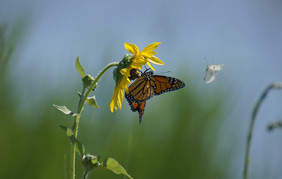Wildlife Selfies Aid Conservation Science
Selfies are a popular way of sharing stories and personal adventures on social media. Wildlife are getting in on the action too – if only inadvertently! Explore adventitious animal “selfies” caught by trail cameras across the United States. From mountains to deserts, increasingly inexpensive (and carefully placed) motion-activated cameras are providing scientists insightful data about animal behavior, distribution, and migration. Bears, bobcats, deer, lynx, ocelots, and mountain lions are just a few of the often elusive creatures captured on cam in their natural habitat. And remember: when you’re taking your own selfies and wildlife photography, always follow trail signs, remain alert, and respectfully maintain a safe distance from any wildlife you encounter.
Bats, Birds and… Booze?!

Bats Pollinate Plants that lead to Tequila; Boozy Birds Overindulge on Fermented Fruits
Thursday, February 22 was National Margarita Day, but it’s not too late to celebrate… by helping bats! Why? Bats pollinate the agave plant that’s used to make tequila. Yes, in addition to providing billions of dollars in ecological services by eating insects, including agricultural pests, bats worldwide also play an important role as pollinators. The lesser long-nosed bat in particular is responsible for agave pollination in North America as it feeds on the plant’s sweet nectar.
Learn about all 47 native bat species across the United States, explore bat conservation projectshappening throughout the country, and discover how you can attract bats to your backyard. And hey, why not enjoy a non-alcoholic margarita while you’re at it?
In other alcohol-related animal revelations, did you know some birds get boozy by overindulging on berries? This phenomenon is attributed to berries frozen during cold winter months fermenting as they thaw; birds feasting on the fermented fruit can become tipsy if they have a few bites too many! Cedar waxwings and robins are two bird species that have been observed imbibing a bit too much, which can sometimes lead to mortality, as the birds’ coordination may be temporarily impaired.
You can create a bird-friendly backyard – for both sober and inebriated wildlife visitors – by implementing these easy, low-cost tips to reduce bird collisions with windows and buildings, which cause over 360 million bird deaths each year in the United States alone.
Did You Know?
 |
Western Monarchs Go CoastalThere are two main monarch butterfly populations in the United States. While the eastern population (located east of the Rocky Mountains, which migrates to Mexico for winter) is most familiar, the lesser-known western monarch population lives west of the Rocky Mountains and overwinters along the California coast and in Baja California, Mexico. These butterflies are in decline, but you can help the colorful pollinators by cultivating native plants (including milkweed), reducing pesticide use, participating in citizen science projects, and learning more about these impressive insects through Monarch Joint Venture’s 2018 monarch conservation webinar series (a free opportunity held on the 4th Tuesday of each month). Photo: Monarch butterfly by Kristin Terwilliger/USFWS |




